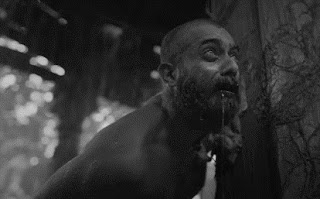Bramayugam heralds the Age of Madness and you wonder why?
 Chaathan is used as a
beautiful metaphor or archetype (as in Jungian theory) -
a primitive mental image inherited from
the earliest human ancestors,
and supposed to be present in the collective unconscious
– to denote Power’s propensity for evil.
Chaathan is used as a
beautiful metaphor or archetype (as in Jungian theory) -
a primitive mental image inherited from
the earliest human ancestors,
and supposed to be present in the collective unconscious
– to denote Power’s propensity for evil.Inequality in Nature being natural, Equality is a human construct, a weak but progressive, attempt towards civilization. So much so that every human tribe-turned-society, naturally settled into class hierarchies weighted by inequalities. The most common divide has been the power struggle between the Haves (oppressor) and the Have-nots(oppressed). And in India including Kerala, this further evolved and fossilized into the complex Chaturvarna, a social stratification and ‘forced occupation’ by each class. The ‘key’ to dominance and discrimination were the access to sacred knowledge (the scripts - Vedas and Upanishads written in Sanskrit). This knowledge led to dominance of a minority elite class (as being ‘divinely chosen’ by Karma to be closer to the Spirits - Divine or Evil). However, exclusivity of knowledge or power invariably leads to misuse finally corrupting a human mind (everywhere and at all times). Seeing the rigid caste hierarchy and discrimination in occupation, clothing, dwellings, Swami Vivekananda (in 18th century) is reputed to have called Kerala, a lunatic asylum (madhouse) or “Keralam oru Branthalayam”! Perhaps, the title makes sense.
A scheduled caste (Paanan) singer (Arjun Ashokan) fleeing from enslavement is mysteriously led to a magical Mana (mansion).The dilapidated declining Mana (mansion) represents Kerala as a society (like Elipathayam), holed away in some remote forest beyond the progress of civilization, symbolically reflecting the Dark Ages (as black and white).
Time – The script and the visuals are replete with the Infinity of Time. ‘Like Time itself, like the river, winding and turning relentlessly. If you cross the steps of this mansion, you will find mountains, rivers, plains nowhere else but here.’The Paanan is repeatedly asked by the cook, if he has any sense of time within the Mana and when he tries to step outside, we see him grown so old indicating the Time passed (a time loop?). And those ‘heaps of graves’ depicting futile attempts by the have-nots (dwellers) before – a subtle nudge at the timeless struggle and futility of human condition.
How dreary, indeed is the passage of time and when one is drowning in a deluge of boredom…Potti says game of dice is the finest remedy to spice up life with a perfect concoction of luck and deceit.
Chess is not just a game here as Kodumon Potti declares ‘you have to gamble on something to play the game’. Though the Paanan understands the deceit of the game (references to Mahabharata), he falls for the rule to pawn his ‘time’ to play for freedom and tricked into enslavement. The lower caste, thus is, subjugated mentally and enslaved to traditions once more. The director Rahul uses Chess here as a tool to hint at debt slavery and the oldest tenants/landlords power struggles in societies.The movie marches on with more explicit power struggles – first, within the elite, between a father (Mammooty - Kodumon Potti) and his illegal son (Sidharth) for power and later between have-nots (paanan) and the illegal son. During these final struggles, when Potti’s illegitimate son tries to wrestle away and wear the ring that denotes control over chaatan (limitless power), paanan (representing the commoner) warns, anyone who chooses to wear the ring will suffer, as power will corrupt him/her eventually. It was also a brilliant idea to show chaatan as a separate entity, waiting patiently for the infightings between the conquerors to conclude. For, the chaatan is confident of controlling the winner finally always. Whoever possess the chaatan feels he is in control while the reverse is actually the truth. Chaatan is a brilliant metaphor for the Human’s potential for Evil.
The ending leaves us with two pointers to the future.
- You see the new dominant class (Westerners) take over and their ‘key of dominance’ being the gun! Shooting down Potti’s illegitimate son is most apt - the message is clear. The old dominance of ‘sacred knowledge’ has been expunged by Gun Powder.
- We also see paanan (the majority or commoner society) getting away with the ring and being possessed by the chaatan – does this signify the ‘democratization’ of sacred knowledge (aka power) to come, probably the future renaissance to hit Kerala (19th century Communism – triumph of the have-nots) – but looking at modern Kerala, one cannot help but wonder - is chaatan still at large?
Will Bramayugam ever end in God’s own Country?





Rajkin has captured nicely story behind and its class based perspectives.The film is really a gripping one and is a true playbook of cinematic brilliance.. The performances of Arjun Ashokan and Sidharth were simply superb. their subtle expressions were so touching and viewers were hooked on from first shot onwards. Mammootty had delivered yet another stunning role as an anti hero. All credits goes to director Rahul Sasidharan and the crew for their technical contributions, stunning visuals and flawless narration. This is a must watch in theatres to experience the chilling showers, eerie nights, dreadful dreams etc..
ReplyDelete